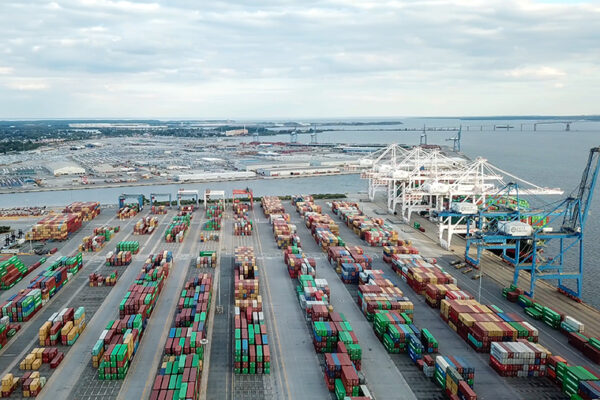Shortly before midnight Sept. 30, nearly 50,000 longshoremen went on strike, affecting operations in 36 ports across the East and Gulf coasts. It is the International Longshoremen Association’s first strike since 1977, and speculation has swirled about how a prolonged strike could affect supply chains and prices in the United States.
These ports handle more than half of the container U.S. shipping trade. Some analysts believe that our supply chains have learned a lot from the pandemic shortages and supply chain failures, and they are prepared for this disruption even if it lasts for a relatively short period of a week or so, said Panos Kouvelis, director of the Boeing Center for Supply Chain Innovation at Olin Business School at Washington University in St. Louis.

But how resilient are the supply chains? And have the necessary investments and policy improvements taken place in recent years to handle this shock? Or will the shock snarl supply chains and drive shortages of all kinds of goods, increase shipping rates and inflate prices across the whole economy?
“All supply chains aspire to be resilient, but economists and supply chain managers will tell you that we always underinvest in it. It does not seem to pay off, until the strike starts,” said Kouvelis, who also is the Emerson Distinguished Professor of Supply Chain, Operations and Technology at Olin.
Below, he discusses the lessons from recent supply chain disruptions and what the U.S. has — and hasn’t — done to prepare for this newest disruption.
Are U.S. supply chains and retailers prepared to weather this strike?
On one hand, we knew the strike was coming. Talks broke down, more or less, in June. In response, retailers ordered earlier and increased inventories. Retailers, who typically treat August through October as the peak shipping period for the coming holiday season, used foresight and shifted holiday-destined shipments between June and September.
Others that are less exposed to heavy season peaks increased their inventories by ordering ahead of the strike and carrying them in their warehouses and distribution systems. That was the case for cars, trucks, heavy and agricultural equipment, and some chemicals and electronics. Some goods, like oil and gas, will not be affected by the strike as they are covered by a separate contract in other terminals. This is good news, but someone will have to pay for higher inventories sitting in warehouses.
Another point of optimism: We’ve gotten good in dynamically deploying available flexibility. Rerouting shipments and using other ports or available shipping capacity allows us to explore less efficient routes through Mexico and Canada. We also can fly certain products instead of ocean shipping. West Coast ports have already agreed on new contracts and are efficiently operating and might have a little capacity to take some of the rerouted container loads, if their longshoremen agree to unload such loads. Hopefully, the Montreal terminal strike that also started on Sept. 30 will only last two to three days — like the Vancouver strike — and could help with some of the load around New York and New Jersey.
Finally, for a short disruption, we can always fly critical products, like pharmaceuticals, and the ones we might be willing to pay the price for, like fresh vegetables for organic connoisseurs — but this will come at a price of three to four times the normal cost.
How might a prolonged disruption impact prices and inventory?
The recent Panama Canal disruption, which is now back to its capacity but with increased demand on its services, and in the Red Sea Suez Canal, where conditions have deteriorated further in response to escalating tensions in the Middle East environment, offer insight on how prices may adjust to the strike disruption.
In both cases, previous investments made by shipping companies to increase capacity combined with optimistic forecasts enabled them to reroute shipments without severe transportation cost increases. In fact, shipping rates dropped substantially in 2023.
However, this past year, we have started seeing that quite a lot of the overcapacity is getting used through such rerouting, and shipping rates have started increasing. Even with a short disruption, some of the capacity will end up waiting at ports and not available to serve other routes. As a result, shipping rates will likely go up — not as much as during the pandemic, but at least by a few thousand dollars per ‘box’ for a few months.
What lessons have we learned — or failed to learn — from the COVID-19 pandemic?
Analysts look at a complex system at a high level, check a few ‘critical resources’ and some easy ‘levers’ that could be pulled, and offer an opinion. It could be they are right, and for a week disruption we have enough port capacity, excess shipping capacity, and other transportation modes to execute alternative movement of goods, including trucks, trains, planes, etc. And currently, big retailers and large durable goods manufacturers have their distribution systems at high levels of inventories to last either through the peak holiday season or a few weeks of regular demand.
But what we learned through the pandemic is that we forget complex systems depend on thousands of small and midsize retailers and suppliers that might not have planned ahead enough, either due to lack of funds or adequate expertise. Sometimes, they are heavily disadvantaged by the actions of the ‘big ones’ that ‘hoarded pre-strike shipments’ and inventories. But if they are not ready to deal with the disruption, even on a short-term basis, it can lead to a bottleneck in production. For example, you need every car part to build or maintain a car — a few missing parts from local suppliers can throw a wrench in the entire production.
There are also auxiliary resources that need to be there for movement of goods to take place, like container chassis, warehouse spaces, truckers and warehouse labor at the right locations, and empty containers.
While ships are waiting to unload in the East and Gulf Coast, we need some of their ‘boxes’ to ship our products to Europe and Asia, and if we are going to go there the West Coast way when the factories are in the Northeast, we need the right trucking capacity, train availability, warehousing infrastructures and labor ready to execute on it.
In a short-term disruption, we are hoping for the innovativeness of our human operators at all stages of the chain to use ‘flexibility’ to get the job done. Even for a short strike, that is not a given. But when the strike stretches on, the shortage in auxiliary resources becomes apparent and severe, and it bottlenecks the supply chain. We saw it during the pandemic, and I expect to see it again as the strike goes on.
This strike is a serious disruption for the U.S. supply chains. If it stretches out over weeks, it will also disrupt global chains. We will see shortages of some goods, including groceries ordered abroad, especially from Latin America and Europe, including whiskey, some wines and beers, certain chocolates and cheeses. We can also expect shipping rates to increase in the next few months, and we will pay higher prices in the coming holiday season. And for one more time we will write stories about ‘how the world ran out of …’ — just fill in the blank.


